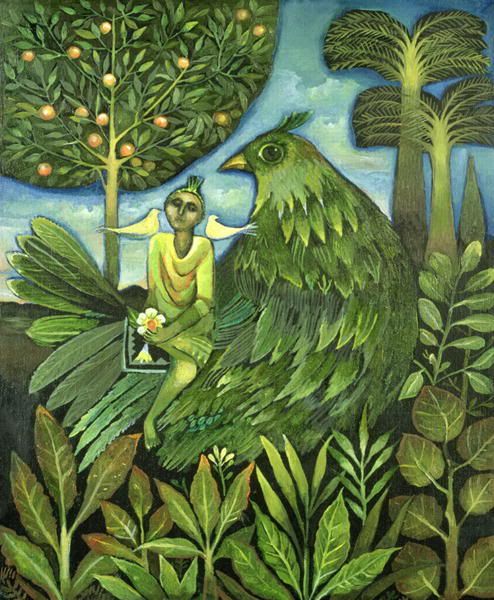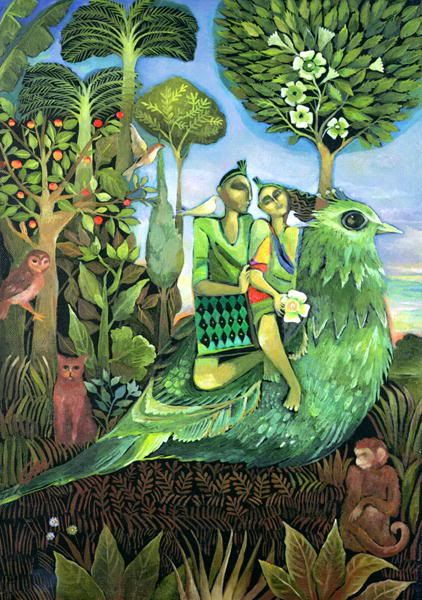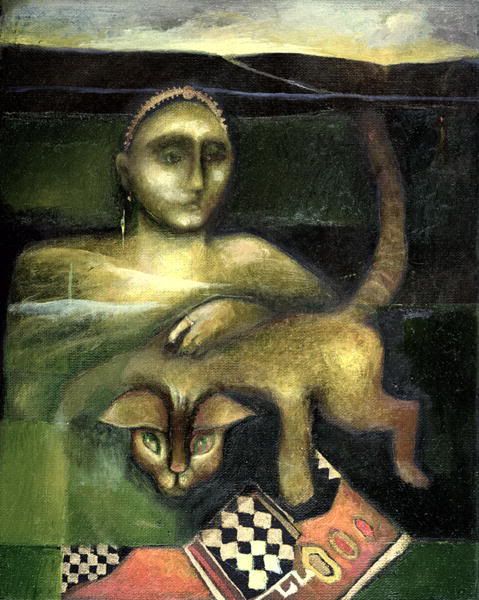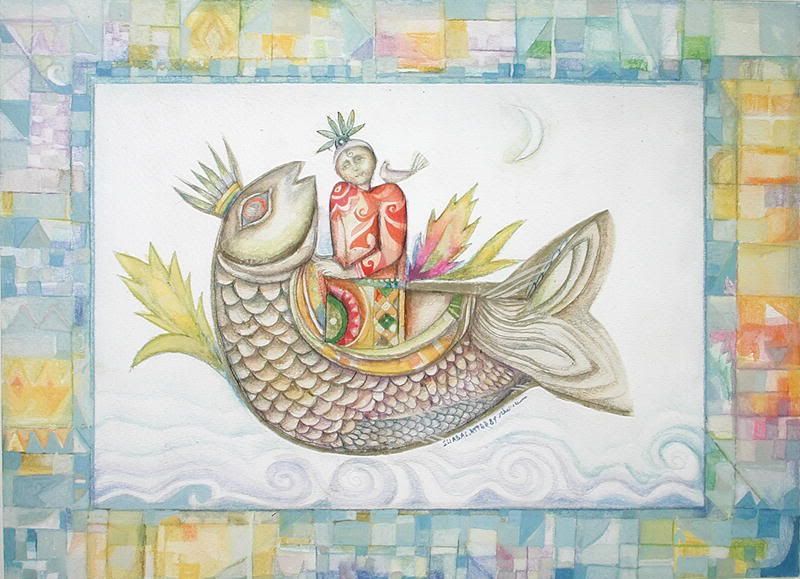|
|
| Пишет kavery ( @ 2007-11-08 12:10:00 |
|
|
|
|
|
|
|
|
|
|
|
|
|
|
Райские картины
Для разнообразия решила разбавить классическую живопись чудесными и добрыми картинами иракской художницы Suad Al-Attar. Надеюсь, что они тоже вам понравятся.

Bird of Paradise, 1992 by Suad Al-Attar

Bird of Paradise, 1992 by Suad Al-Attar

Her Happiness was but a Dream, 1996 by Suad Al-Attar

Spirit from the Past, 1999 by Suad Al-Attar

Dream of a Fish, 1989 by Suad Al-Attar

Gilgamesh and Enkido
Gilgamesh and Enkido is based on a Sumerian legend. Gilgamesh, the hero-king of the ancient Sumerian city of Uruk, is depicted emerging from a dark, cavernous background. He has the body of an animal and a highly emotive and luminous feminine face, suggesting the artist's desire to create a powerful female image and invent a new role for women in an otherwise male-dominated legend. The animal represents the winged bull of Assyria with its strong and upright legs. Gilgamesh is flanked by his foe turned friend and companion Enkido, whose presence in the painting symbolizes the relationship between a man/god (Gilgamesh) and an animal/man (Enkido); the latter represents nature with his attributes of strength, wildness, and innocence. This painting reflects a tension between the yearnings and aspirations of the human spirit as opposed to the heaviness and earthbound animal-like body. The Epic of Gilgamesh, one of most famous literary works in the world, is 4,000 years old and is based on the Sumerian story of Gilgamesh, the ancient king of Uruk. The story (which underwent several elaborations by subsequent civilizations) was finally recorded in an Akkadian version in the seventh century B.C. and stored in the library of Ashurbanipal, the Assyrian king. Discovered in the mid-nineteenth century, the text of the Epic was written on clay tablets, each tablet containing 200 to 300 lines. Particularly notable is the story of the flood, which preceded the version in the Old Testament.
Suad al-Attar (Arabic,سعاد العطار)(born 1942) is a renowned Iraqi painter[1] whose work is in private and public collections worldwide, including The British Museum and the Gulbenkian Collection. She has held over twenty solo exhibitions, including one in Baghdad that became the first solo exhibition in the country's history for a woman artist. Her many awards include the first prize at the International Biennale in Cairo in 1984 and an award of distinction at the Biennale held in Malta in 1995.
Suad left Baghdad with her husband and children in 1976, and settled in London. For her, the perpetual sense of longing for "home" has always been balanced by an awareness of the freedom that comes with distance. This freedom—a condition that gained added significance following the regime’s rise to power under Saddam Hussein in the late 1970s—has enabled her to explore her relationship with her homeland and to develop a personal visual language with which to express it.
Elements of this language are to be found within the traditions of Middle Eastern art. The winged creatures of Assyrian reliefs, Sumerian sculptures and the illuminated manuscripts of the Baghdadi School were instrumental. However, this awareness of her Arab heritage did not result in slavish imitation, but was forged with her own romantic imagination and an appreciation of western figurative traditions to create enigmatic images in which narrative and symbolism are intertwined.
A substantial monograph documenting her career was published in London in 2004. Much of Suad’s painting is characterised by an intense dreamlike and poetic sensibility that draws on motifs and symbols from within the traditions of Middle Eastern art. In recent years, these richly-coloured representations of paradise and of sleeping cities bathed in turquoise blue, have disappeared from her work as she has become increasingly preoccupied with the plight of Iraq (Из wikipedia )
Born in Iraq, Suad al-Attar studied art in Baghdad, San Francisco, and London. She was the first Iraqi woman artist to have a solo exhibition in Baghdad, in 1964. Attar's work is deeply embedded in the layered, historical traditions of her homeland, and yet she is unique in her ability to create and reinvent imagery inspired by Arabic literature, ancient Sumerian mythological texts, and her own representational search for symbolism and dreams. (http://www.metmuseum.org/toah/hd/almi/h
Для разнообразия решила разбавить классическую живопись чудесными и добрыми картинами иракской художницы Suad Al-Attar. Надеюсь, что они тоже вам понравятся.

Bird of Paradise, 1992 by Suad Al-Attar

Bird of Paradise, 1992 by Suad Al-Attar

Her Happiness was but a Dream, 1996 by Suad Al-Attar

Spirit from the Past, 1999 by Suad Al-Attar

Dream of a Fish, 1989 by Suad Al-Attar

Gilgamesh and Enkido
Gilgamesh and Enkido is based on a Sumerian legend. Gilgamesh, the hero-king of the ancient Sumerian city of Uruk, is depicted emerging from a dark, cavernous background. He has the body of an animal and a highly emotive and luminous feminine face, suggesting the artist's desire to create a powerful female image and invent a new role for women in an otherwise male-dominated legend. The animal represents the winged bull of Assyria with its strong and upright legs. Gilgamesh is flanked by his foe turned friend and companion Enkido, whose presence in the painting symbolizes the relationship between a man/god (Gilgamesh) and an animal/man (Enkido); the latter represents nature with his attributes of strength, wildness, and innocence. This painting reflects a tension between the yearnings and aspirations of the human spirit as opposed to the heaviness and earthbound animal-like body. The Epic of Gilgamesh, one of most famous literary works in the world, is 4,000 years old and is based on the Sumerian story of Gilgamesh, the ancient king of Uruk. The story (which underwent several elaborations by subsequent civilizations) was finally recorded in an Akkadian version in the seventh century B.C. and stored in the library of Ashurbanipal, the Assyrian king. Discovered in the mid-nineteenth century, the text of the Epic was written on clay tablets, each tablet containing 200 to 300 lines. Particularly notable is the story of the flood, which preceded the version in the Old Testament.
Suad al-Attar (Arabic,سعاد العطار)(born 1942) is a renowned Iraqi painter[1] whose work is in private and public collections worldwide, including The British Museum and the Gulbenkian Collection. She has held over twenty solo exhibitions, including one in Baghdad that became the first solo exhibition in the country's history for a woman artist. Her many awards include the first prize at the International Biennale in Cairo in 1984 and an award of distinction at the Biennale held in Malta in 1995.
Suad left Baghdad with her husband and children in 1976, and settled in London. For her, the perpetual sense of longing for "home" has always been balanced by an awareness of the freedom that comes with distance. This freedom—a condition that gained added significance following the regime’s rise to power under Saddam Hussein in the late 1970s—has enabled her to explore her relationship with her homeland and to develop a personal visual language with which to express it.
Elements of this language are to be found within the traditions of Middle Eastern art. The winged creatures of Assyrian reliefs, Sumerian sculptures and the illuminated manuscripts of the Baghdadi School were instrumental. However, this awareness of her Arab heritage did not result in slavish imitation, but was forged with her own romantic imagination and an appreciation of western figurative traditions to create enigmatic images in which narrative and symbolism are intertwined.
A substantial monograph documenting her career was published in London in 2004. Much of Suad’s painting is characterised by an intense dreamlike and poetic sensibility that draws on motifs and symbols from within the traditions of Middle Eastern art. In recent years, these richly-coloured representations of paradise and of sleeping cities bathed in turquoise blue, have disappeared from her work as she has become increasingly preoccupied with the plight of Iraq (Из wikipedia )
Born in Iraq, Suad al-Attar studied art in Baghdad, San Francisco, and London. She was the first Iraqi woman artist to have a solo exhibition in Baghdad, in 1964. Attar's work is deeply embedded in the layered, historical traditions of her homeland, and yet she is unique in her ability to create and reinvent imagery inspired by Arabic literature, ancient Sumerian mythological texts, and her own representational search for symbolism and dreams. (http://www.metmuseum.org/toah/hd/almi/h